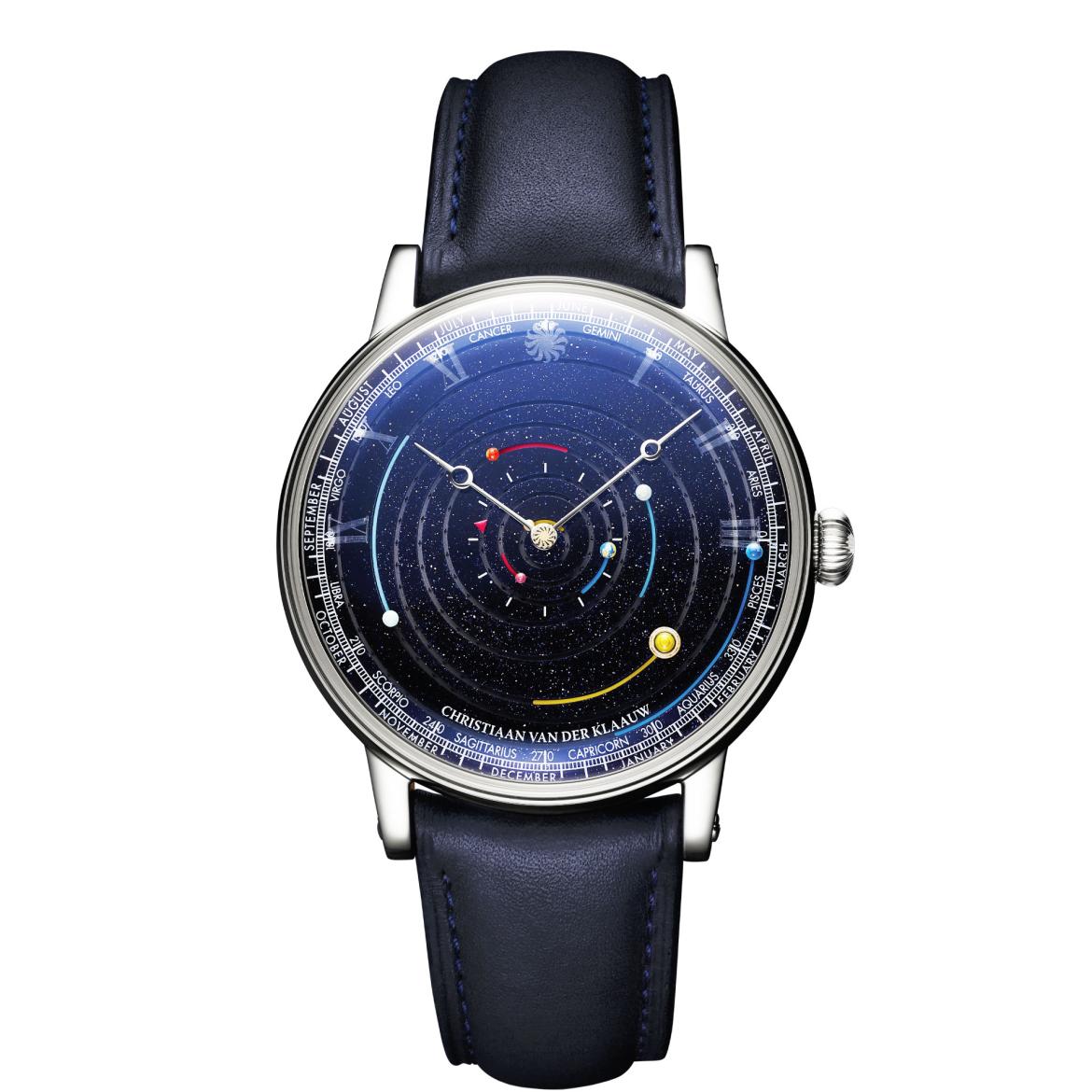Quick specs Christiaan van der Klaauw Grand Planetarium Eccentric Manufacture
Price:
Approx. $ 230,000 | € 208.000 | approx. £ 175,000 | approx. CHF 200’000 (rose gold)
Approx. $ 250,000 | € 227.000 | approx. £ 190,000 | approx. CHF 215’000 (platinum)
Size: 44 mm
Reference:
CKGP1104 (rose gold)
CKGP2204 (platinum)
Table of contents
- All three generations worked on the Grand Planetarium Eccentric
- Seven years of development
- Background of CVDK’s new CEO Pim Koeslag
- Pim Koeslag and Christiaan van der Klaauw have a 26-year-old link
- From industrialized watchmaking to hand-made watches
- The planetarium is a horological miracle
- What is an eccentric planetarium?
- Zodiac calendar vs Gregorian calendar
- Reading the date, month, and zodiac signs
- How does the planetarium technically work?
- The dial is made from aventurine rings
- 44-millimeter case to house the planetarium
- The Christiaan van der Klaauw Grand Planetarium Eccentric Manufacture has a power reserve of 60 hours
- Price of the CVDK Grand Planetarium Eccentric Manufacture
- Ready for the third generation
This Christiaan van der Klaauw Grand Planetarium Eccentric Manufacture is the apotheosis of the brand under the leadership of Daniël Reintjes and his wife Maria Reintjes-Van Laar. They took over the Dutch brand (founded in 1974) in 2009 directly from founder Christiaan. Since then, they have followed a meticulous path to conquer a vacant lot in horology: astronomical watches.
In 15 years, they have expanded the brand and won awards, giving it international allure and a clear, recognizable design language. The dial has indexes only on the top part and the astronomical complication on the lower part. Together, they depict the horizon, one of their signature features. With a new logo, a sun formed of 12 claws at the top of each dial. As “Klaauw” means “claw” in Dutch, and you can guess why there are 12 of them…
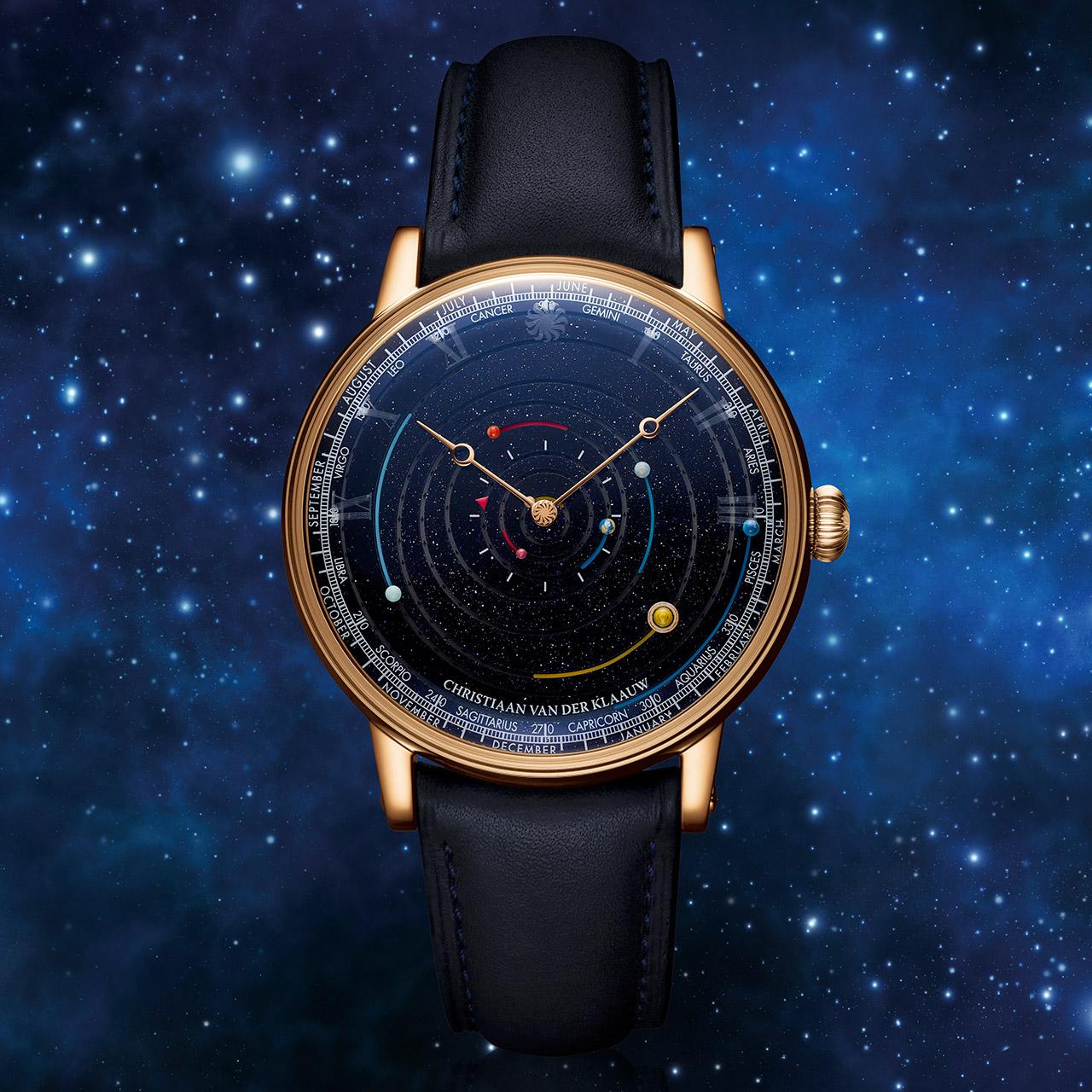
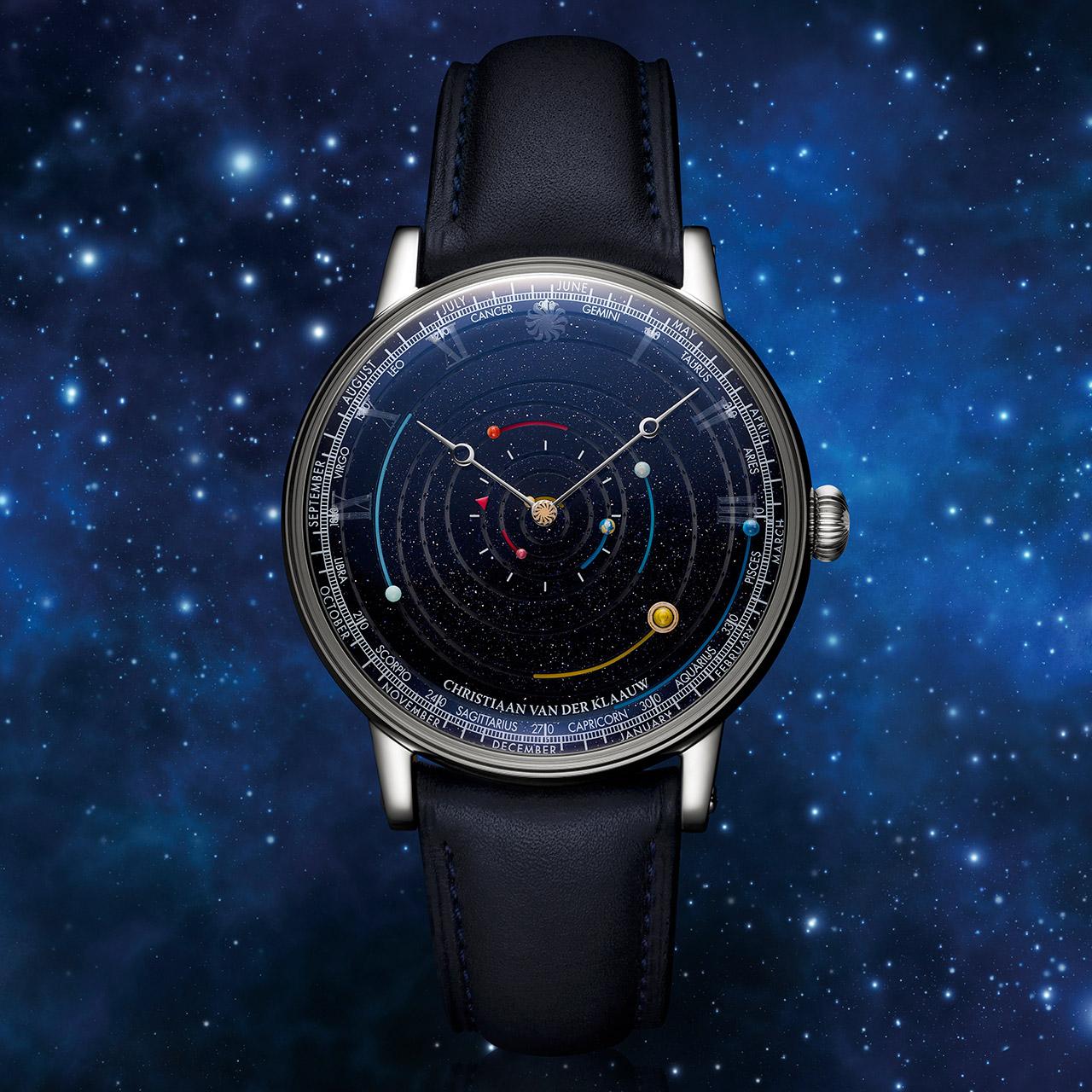
All three generations worked on the Grand Planetarium Eccentric
The couple sold the company to Pim Koeslag, who started in 2022, and for him, this Grand Planetarium marks the continuation of the brand under his leadership. The third generation, so to say, and this launch also marks 50 years of the brand Christiaan van der Klaauw, also known as CVDK.
And for this golden celebration, all three generations worked on this Grand Planetarium Eccentric. Already in 2013, the first sketches were made by Daniël Reintjes (second generation). With his earlier developed “regular” planetarium as a base, drawings were made for a dial design, influenced by Maria’s input (also second generation). The second stage was the technical drawings for which they asked founder Christiaan van der Klaauw himself, the first generation.
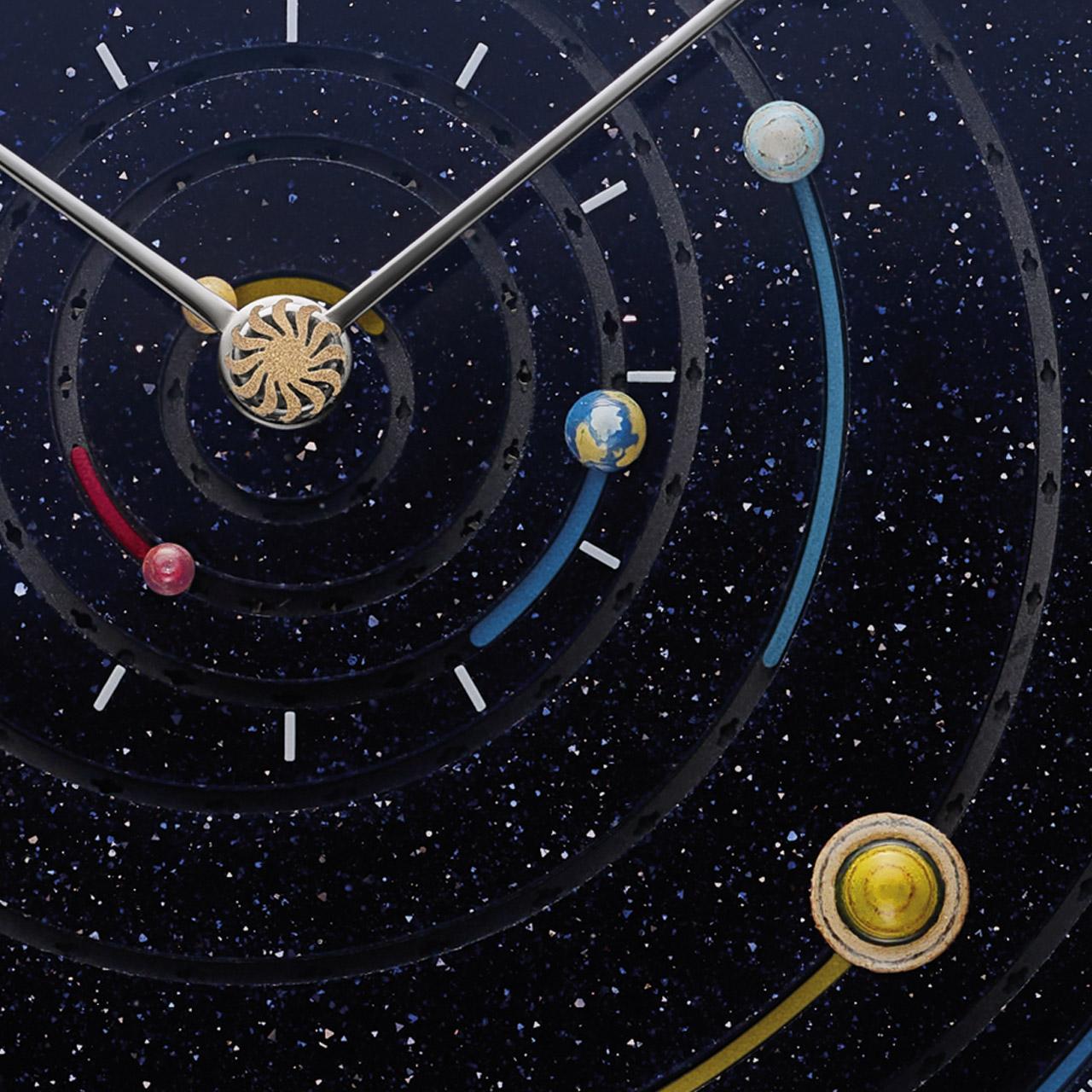
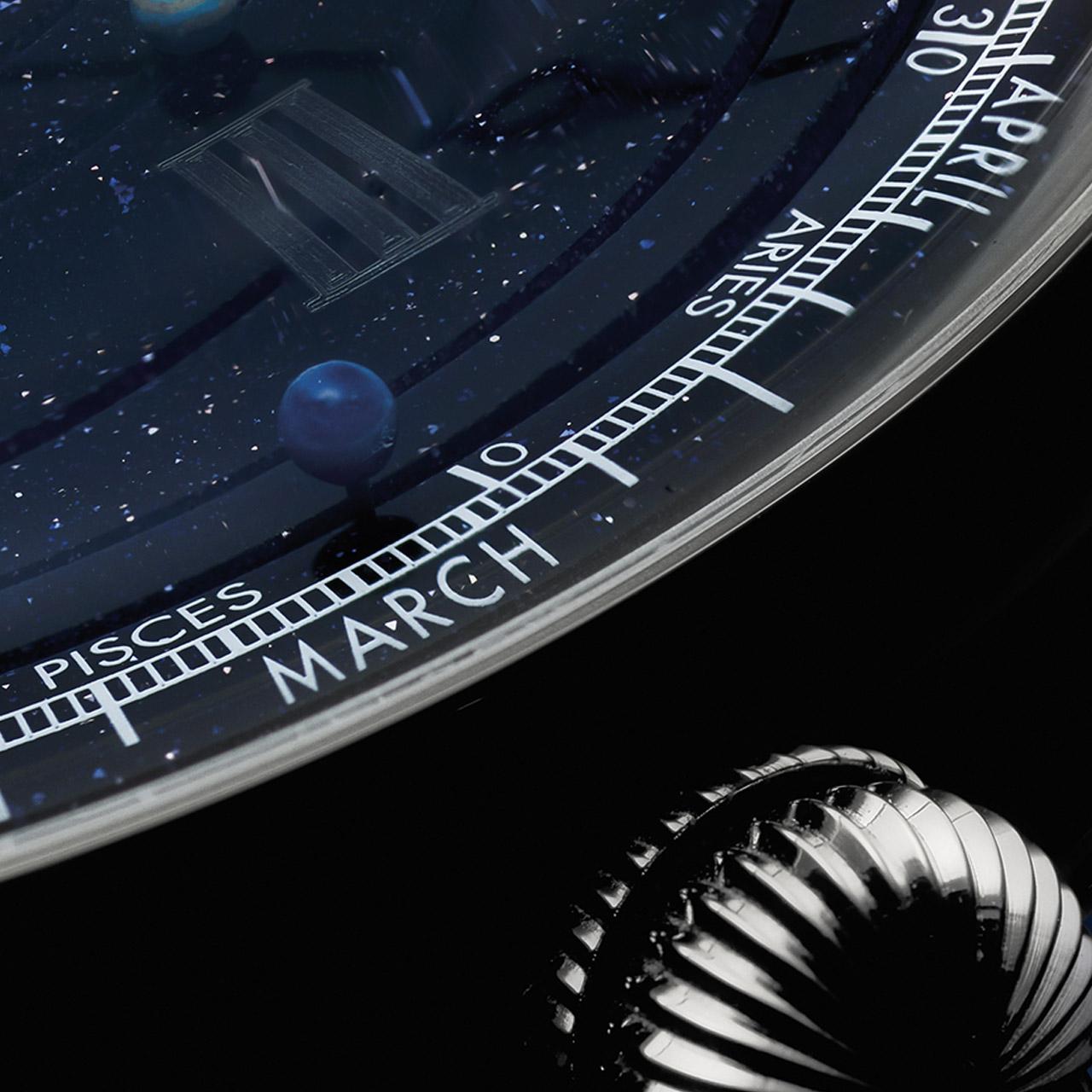
Seven years of development
Christiaan has drawn his concepts and calculations, on paper, based on his own Kepler’s Planetarium Clock he developed earlier, in 1995. After digitalizing this all, the technical development could start. It took up to seven years and when the rough concept was polished, the third generation, Pim Koeslag entered the company.
He used his experiences and business connections for further development leading to the final model. An example of this is the case of the new model, which he obtains from a case maker with three clients only: Patek, Audemars, and CVDK.
Background of CVDK’s new CEO Pim Koeslag
Pim Koeslag graduated from the Amsterdam watchmaking school. He did internships at brands like Grönefeld, also Dutch, and Patek Philippe before starting to work for Frederique Constant. Eventually becoming the technical director.
He is responsible for some technical highlights at FC, with in-house tourbillons, perpetual calendars, and the high-beating Monolithic caliber. Used in this recent Frederique Constant × Revolution Slimline Monolithic Manufacture FP(G) for instance.
Pim Koeslag and Christiaan van der Klaauw have a 26-year-old link
Under the wings of Frederique Constant, he also co-founded Ateliers deMonaco, and since 2022 he has become the majority shareholder of CVDK, together with some informal investors. After 20 years of working in the Swiss watch industry.
However, already 26 years ago he met founder Christiaan van der Klaauw, according to an interview he had in December 2023 with Revolution Watch. He followed Christiaan’s advice to work in Switzerland for a couple of years before a possible partnership with CVDK could occur. That “couple of years” became 26 years.
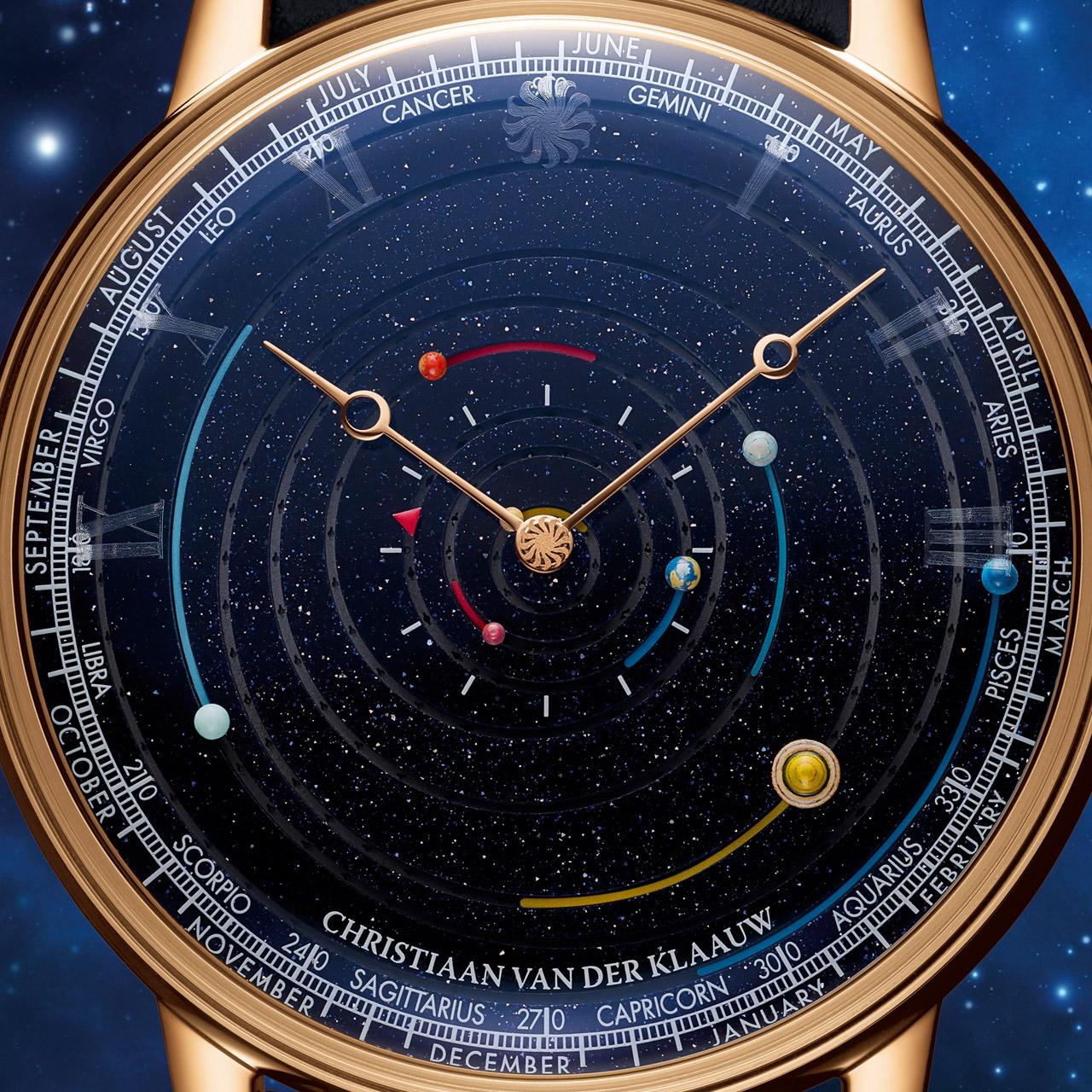
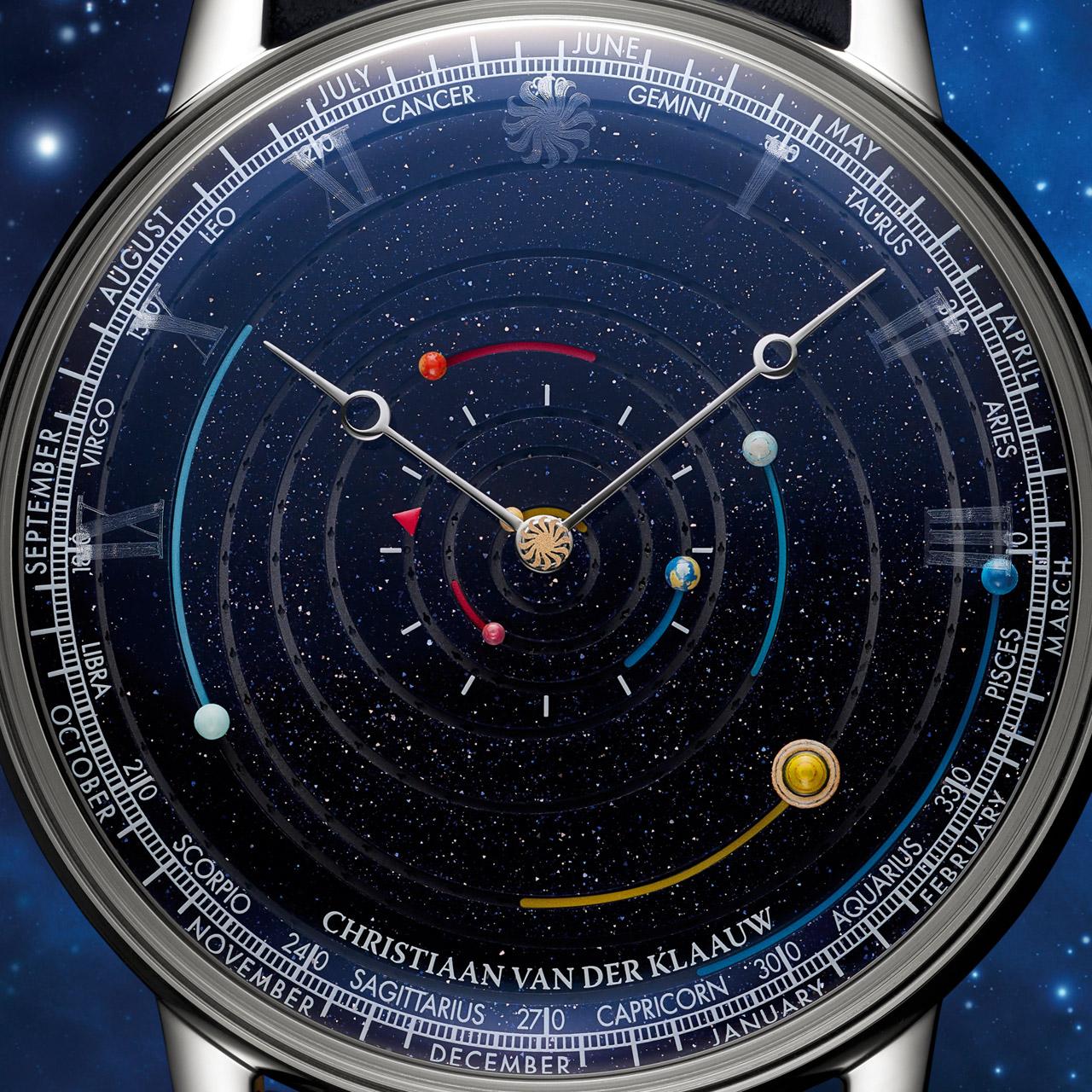
From industrialized watchmaking to hand-made watches
For Pim Koeslag his transfer from Frederique Constant to owner and CEO of CVDK means going from industrialized watchmaking to almost fully hand-made watches. It starts with the movement, the gear trains and pinions, the wheels including cutting the teeth, and astronomical modules. Almost all are produced in-house and by hand.
The base of the movement of the CVDK Grand Planetarium Eccentric Manufacture was developed for CVDK by the small Swiss high-end manufacturer UhrTeil AG. Based on CVDK’s instructions. From there it goes to The Netherlands for the final finishing and integration with possible complications.
This new planetarium for instance, but there is also space for their 3D moon, like this Christiaan van der Klaauw Real Moon Joure Green Meteorite. So, this Christiaan van der Klaauw caliber CKM-01 also forms a base for future CVDK models. And is called “manufacture” or “in-house” as it was designed for and with the instructions of CVDK and finished by CVDK. We’ll come back to the specs later.
The planetarium is a horological miracle
Earlier, the brand already created the world’s smallest mechanical planetarium with this Christiaan van der Klaauw Planetarium, also in a Dunes of Mars edition. And they have made price-winning planetariums for Van Cleef & Arpels.
All fascinating timepieces with parts of the complication that will only fully turn about twice in the lifetime of the owner. However, this new Eccentric Planetarium takes it a huge step further, with a planet fully rotating only once every 164.80 years. No one will see that happen in their life.
What is an eccentric planetarium?
An eccentric planetarium is a mechanical construction, here showing all eight planets and their elliptical orbit around the sun in real time. On the dial Mercury, Venus, Earth, Mars, Jupiter, Saturn, Uranus, and Neptune turn around the Sun, each with their speed, and each in their specific orbit. Which is also linked to the zodiac calendar, here visible on the outer ring of the dial. The orbit speeds of the planets around the sun are:
- Mercury: 87.97 days
- Venus: 224.7 days
- Earth: 365.24 days
- Mars: 686.98 days
- Jupiter: 11.86 years
- Saturn: 29.46 years
- Uranus: 84.02 years
- Neptune: 164.8 years
At the heart of the dial lies the sun, which is also a seconds indicator as it turns once every 60 seconds. This sun is surrounded by eight revolving planets showcasing their real-time positions and also mimicking their actual speeds on their eccentric path. The closest to the sun is Mercury, and the most away is Neptune. As said, making a full turn around the sun once every 164.8 years. This means it also makes a full turn on the dial of this Grand Planetarium Eccentric Manufacture. The picture below shows the orbits:
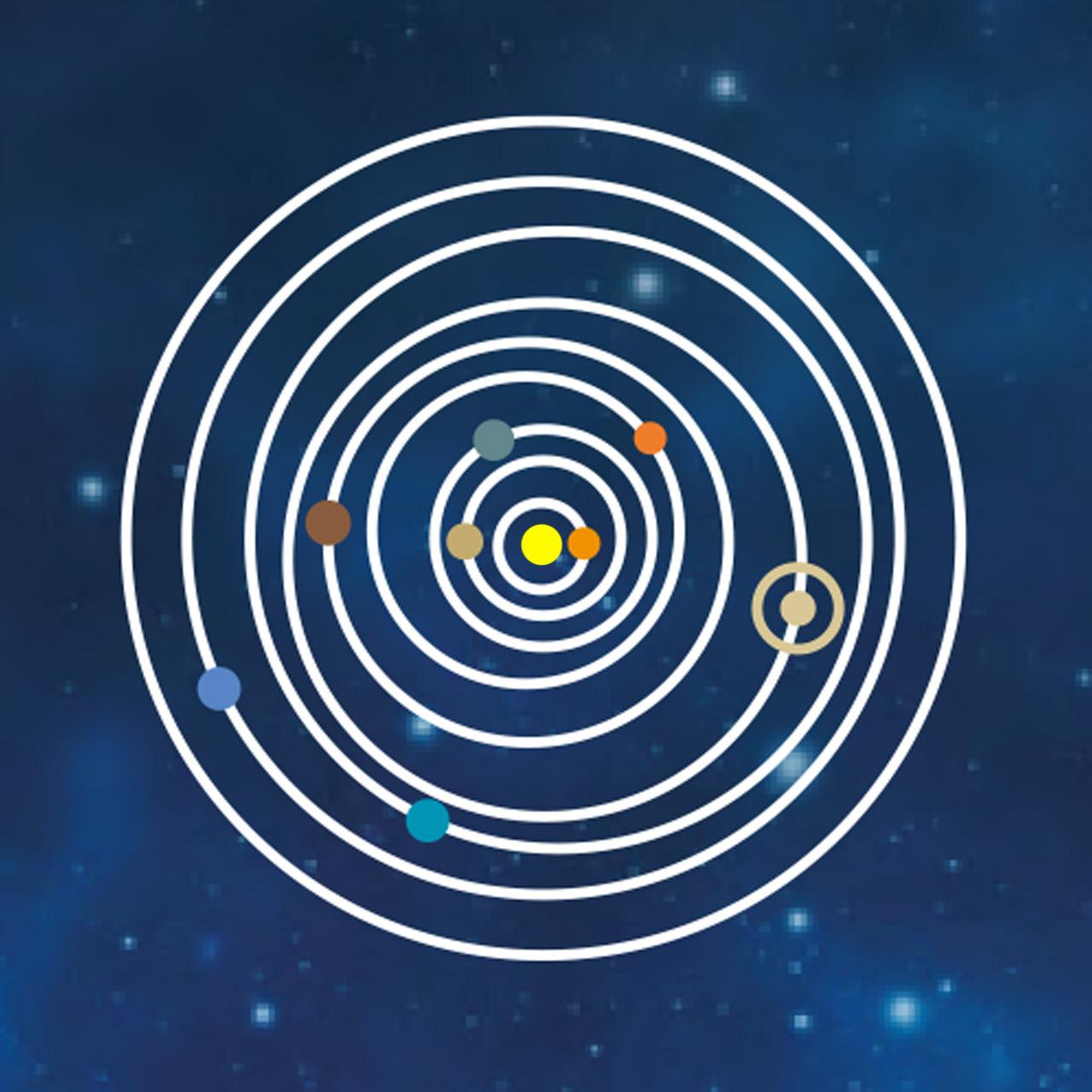
Zodiac calendar vs Gregorian calendar
The speed of the orbit of the planets is connected to the zodiac calendar. All planets orbit in roughly the same plane. As the Earth orbits the Sun, from our perspective, the Sun appears to move through the twelve zodiac constellations throughout the year.
Now, our Gregorian calendar divides the year into twelve months, which is a solar year that lasts 365.24 days. The time the Earth needs to orbit the sun. While the zodiac calendar divides the year into twelve signs. Although there are twelve periods in both systems, they don’t align exactly in terms of dates. And you can see that difference on the outer ring of the dial.
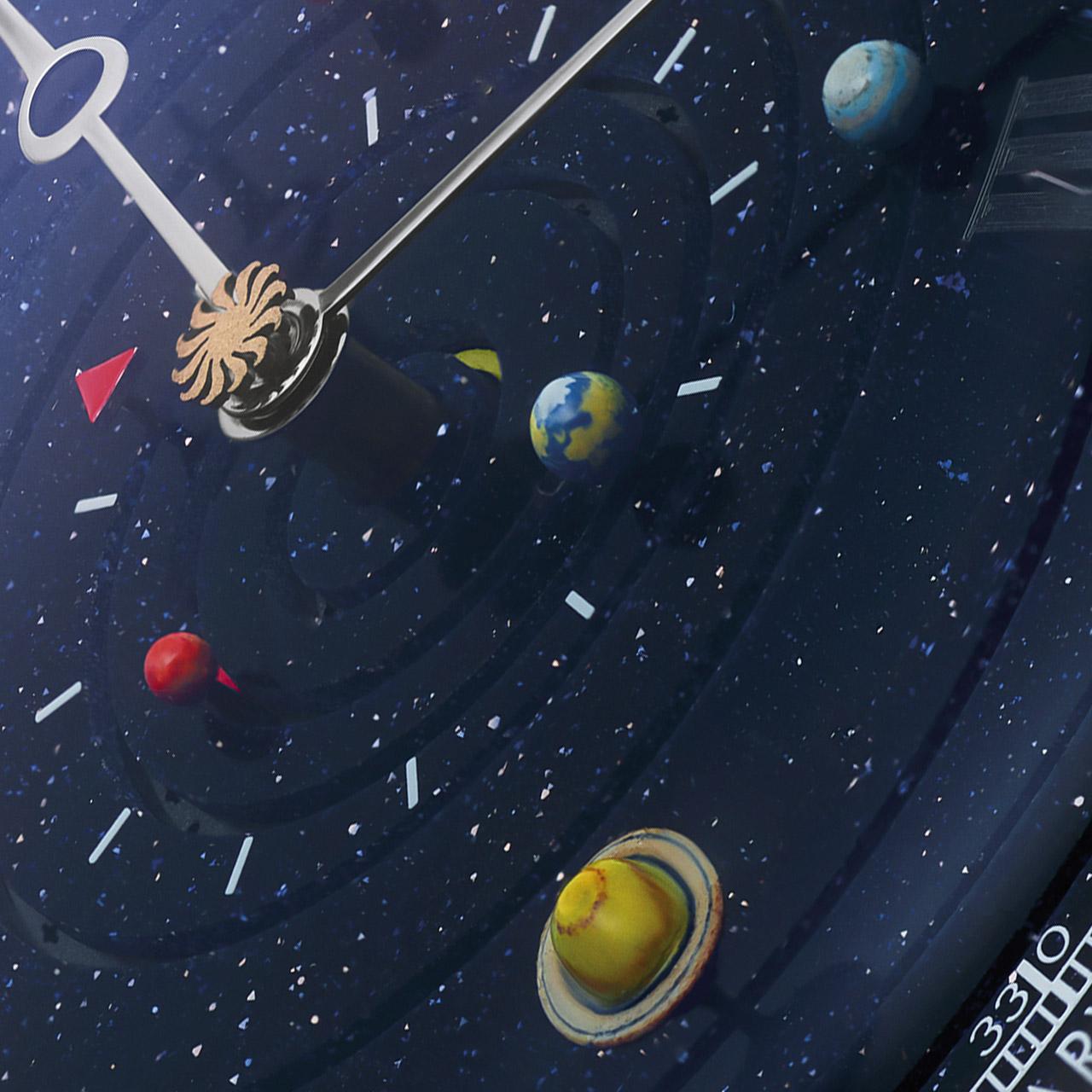
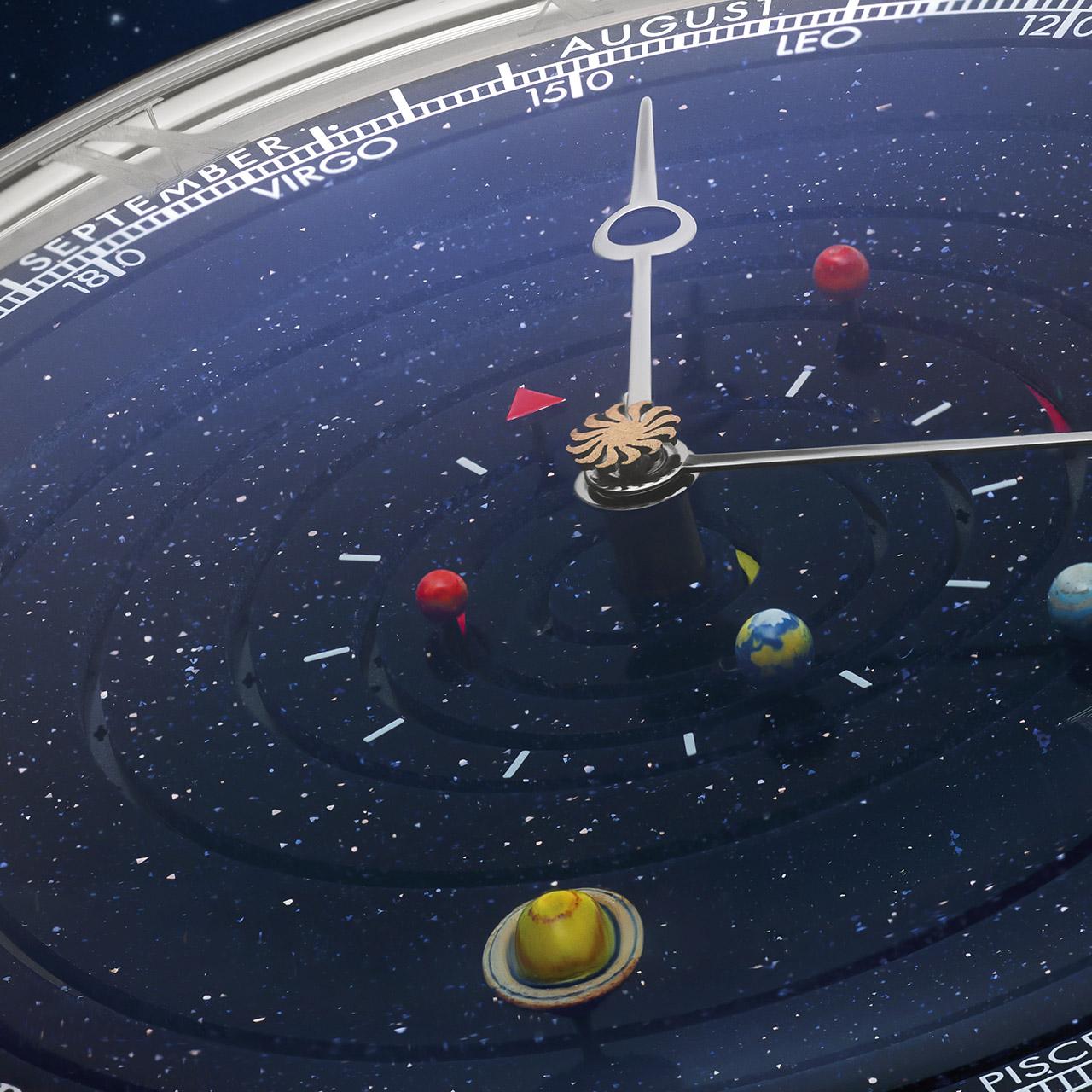
Reading the date, month, and zodiac signs
The track under the month indications shows all the days of that month. To read the day, month, and zodiac signs you have to follow a virtual line from the Earth to the Sun and from there extend that line to the outer ring. A little red arrow helps a bit. So, in the picture below the applied green line goes from the Earth, through the heart of the Sun, following the red arrow applied on the dial, up to the 9th of September in the zodiac sign Virgo.
Without our drawn green line, it is not that easy to read the date, but it’s there. And technically the date, month, and zodiac signs are not a mechanical complication here. You can read them because one can do some math with the mechanical complication that shows the Earth’s position relative to the sun. It’s like a tachymeter, also not a mechanical complication. But helped by the seconds counter of a chronograph, which is a complication, and the math on the tachymeter scale, it can show a speed.
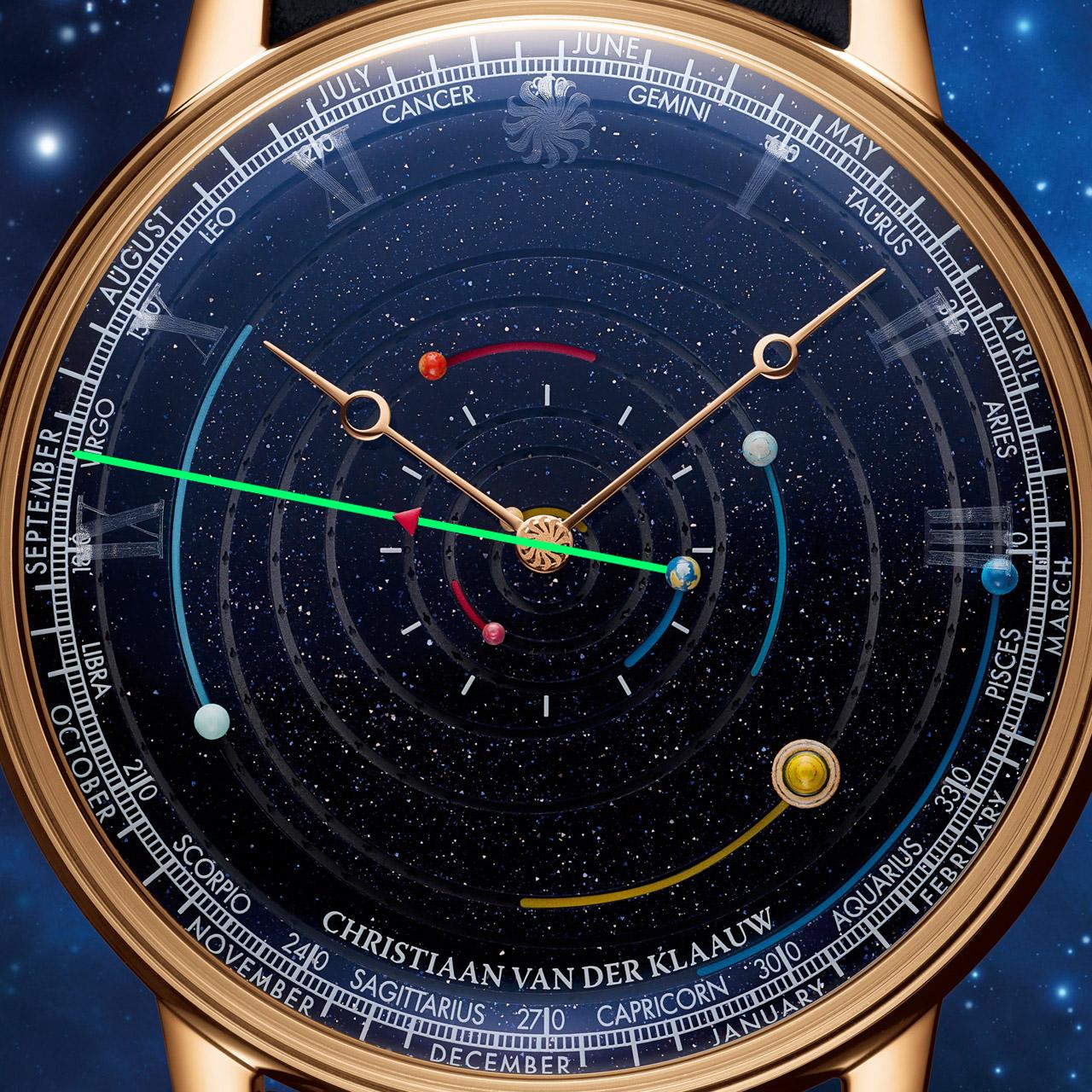
How does the planetarium technically work?
The working of this planetarium is quite simple. In theory, that is. It all starts with the hour wheel of the movement. They connect it to a gear that reduces the speed to match a monthly cycle, which provides the date, in short. Reducing this again leads to the cycle of a year, providing the month. From there they reduce the speed to match each planet’s orbital speed around the sun.
So, each planet has its own gear underneath the dial. A large one for the slowest orbiting planets and a small one for the fastest. And these gears fit within each other to prevent the watch from being too thick.
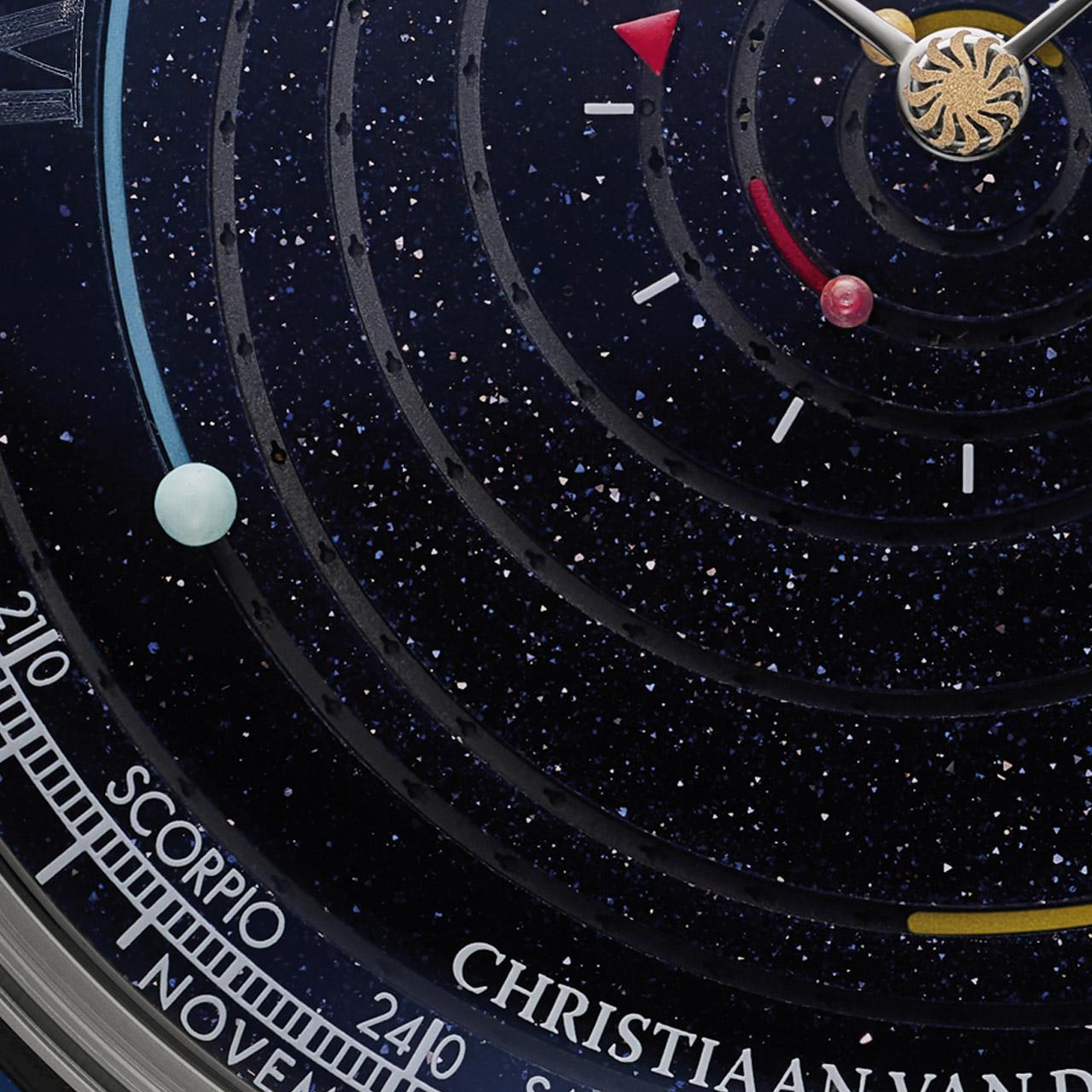
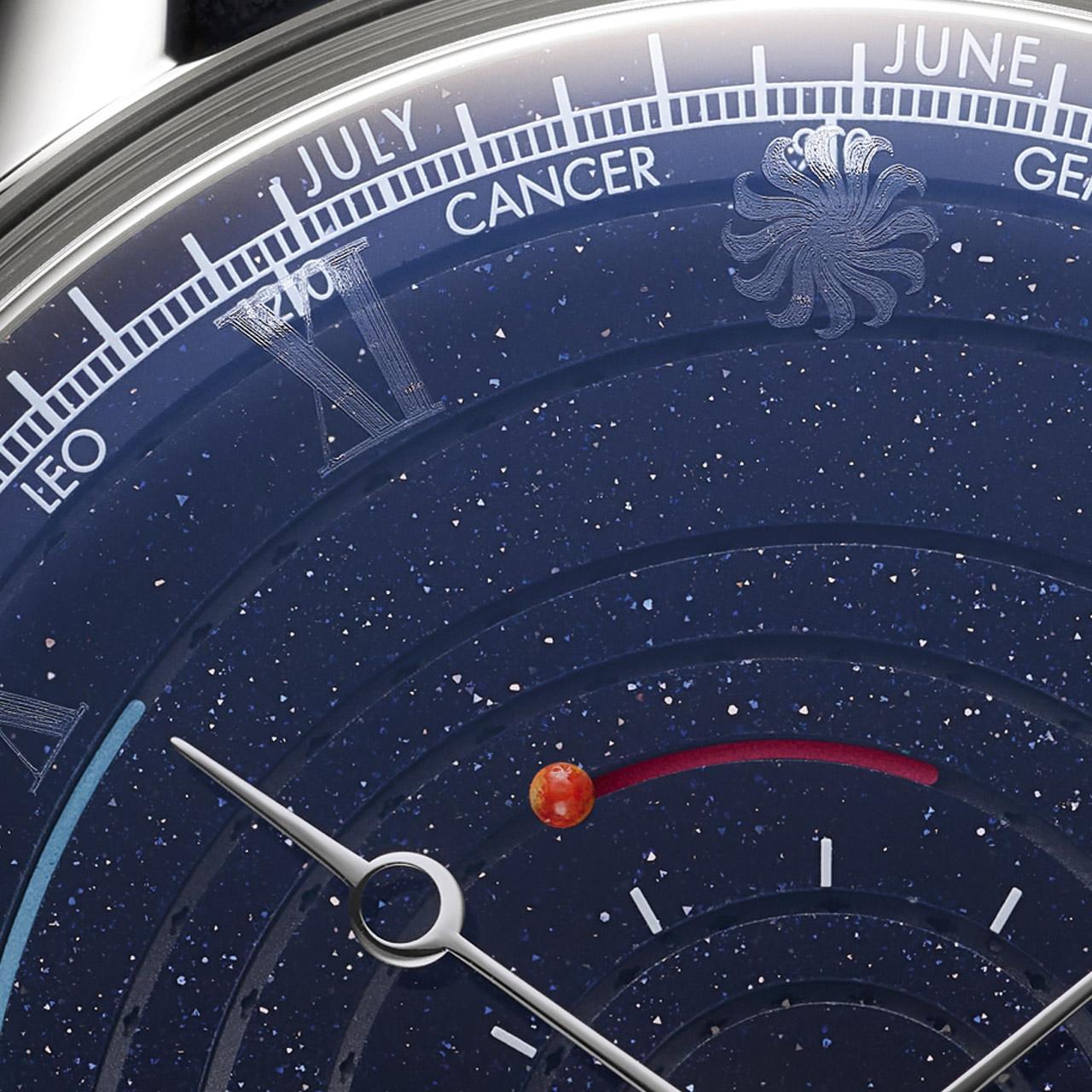
The dial is made from aventurine rings
Each gear of a planet has its own aventurine ring forming the dial. The aventurine is a mineral quartz, translucent, and has a shimmering and glistening effect. Perfect for an astronomical watch. Furthermore, you can clearly see distances between these rings as they need some space to move eccentrically.
The aventurine rings have a small hole in which each planet is pinned. The size of these planets, which are in proportion to each other varies between 0.8 and 1.2 millimeters, unpainted. As they are all hand-painted so you can actually see the poles on Earth and the massive storm on Jupiter called the Great Red Spot. Of course, the planets never collide however the distance between them when they pass each other is extremely small.
44-millimeter case to house the planetarium
The case is available in either 18k rose gold or platinum and has a diameter of 44 millimeters with a thickness of 14 millimeters. Smaller wasn’t simply possible for the movement with its complication. On top of the case is domed sapphire crystal, which you cannot see in the photos very well, but it really looks good in real. Classic and sturdy at the same time.
The case is also slightly adjusted compared to the formerly used cases as the lugs have bowed ends, creating a claw shape. And if you miss the signature numerals on the upper part of the dial, take a good look at the photos. They are still there. Engraved in the sapphire crystal. The case back is also from sapphire crystal giving the owner a perfect view of the new movement.
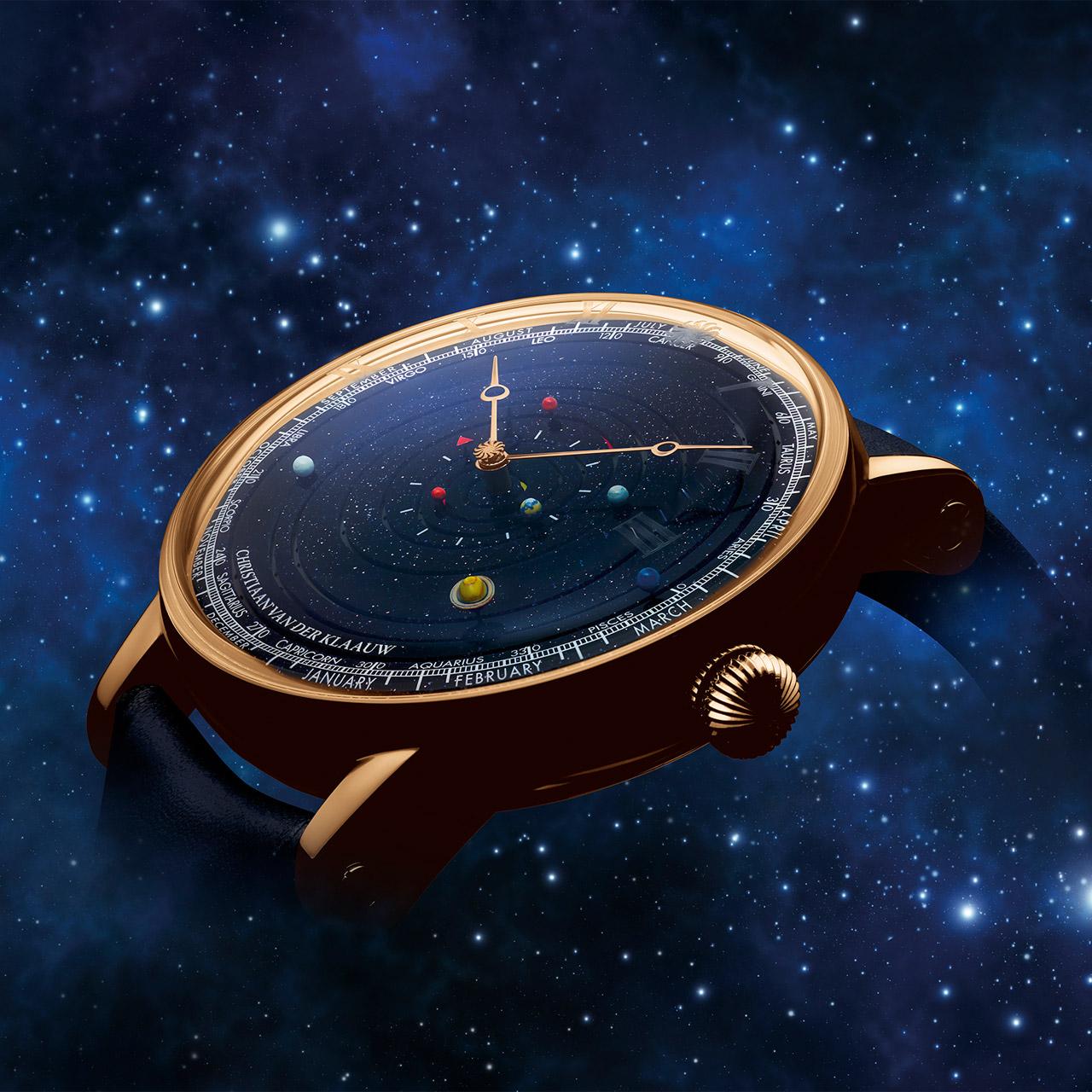
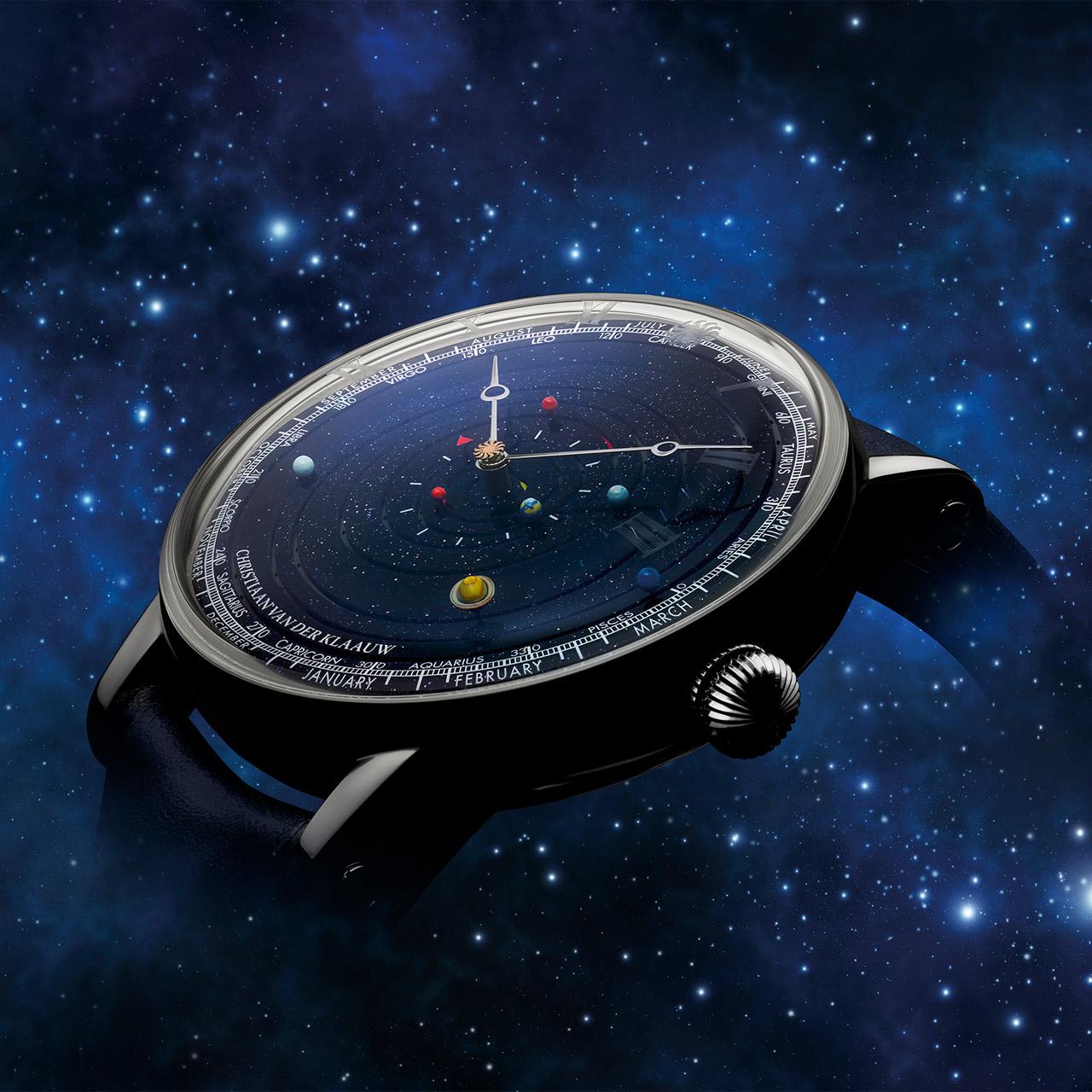
The Christiaan van der Klaauw Grand Planetarium Eccentric Manufacture has a power reserve of 60 hours
As said, the movement of the Christiaan van der Klaauw Grand Planetarium Eccentric Manufacture is the new Christiaan van der Klaauw caliber CKM-01, here with an eccentric planetarium module. More in than on it. To match the astronomical character of all their watches, it has star-shaped bridges with circular hand finishes.
Also frosted star decoration with rhodium plating, perlage decoration, and rhodium plating on the main plate. Finished with a skeletonized rose gold plated brass winding rotor in the shape of the CVDK logo: the renewed sun with 12 claws. This unidirectional automatic winding rotor has a rhodium-plated tungsten weight on the outside diameter and the power reserve is 60 hours.
You don’t have to worry about adjusting all the planets when your watch runs out of power unexpectedly, as the module has a “quick planet setting”. You can just move planets forward and backward to align them with the right date.
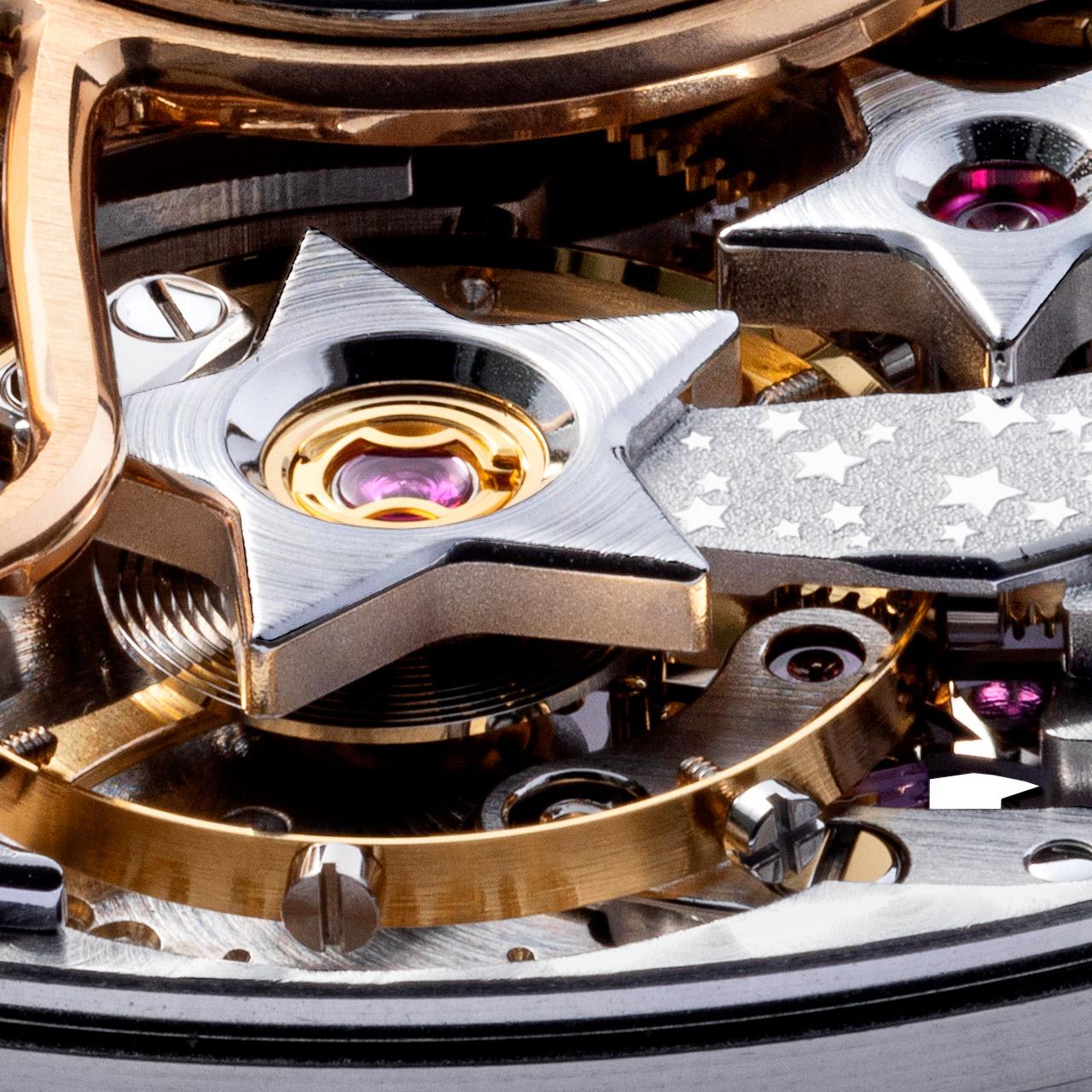
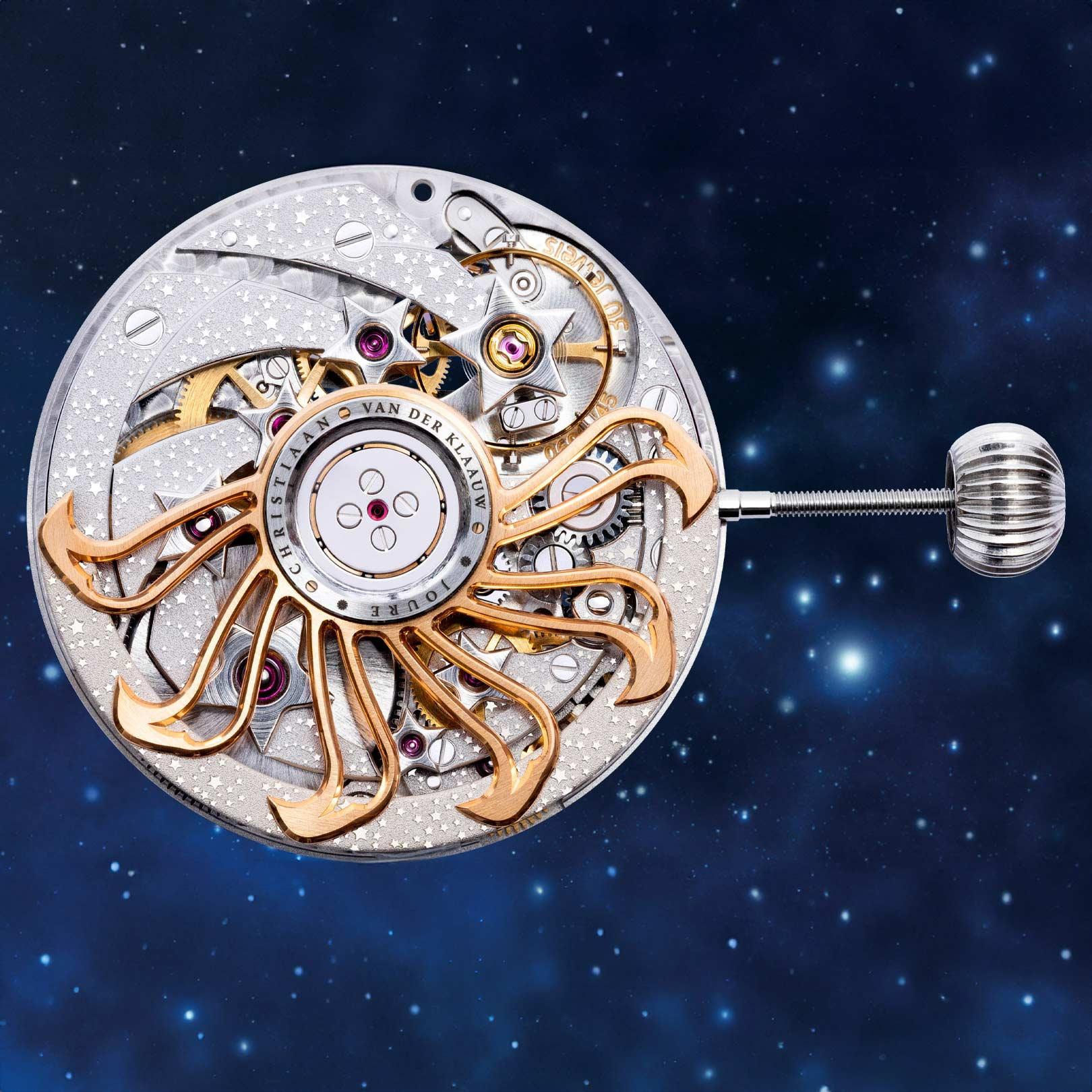
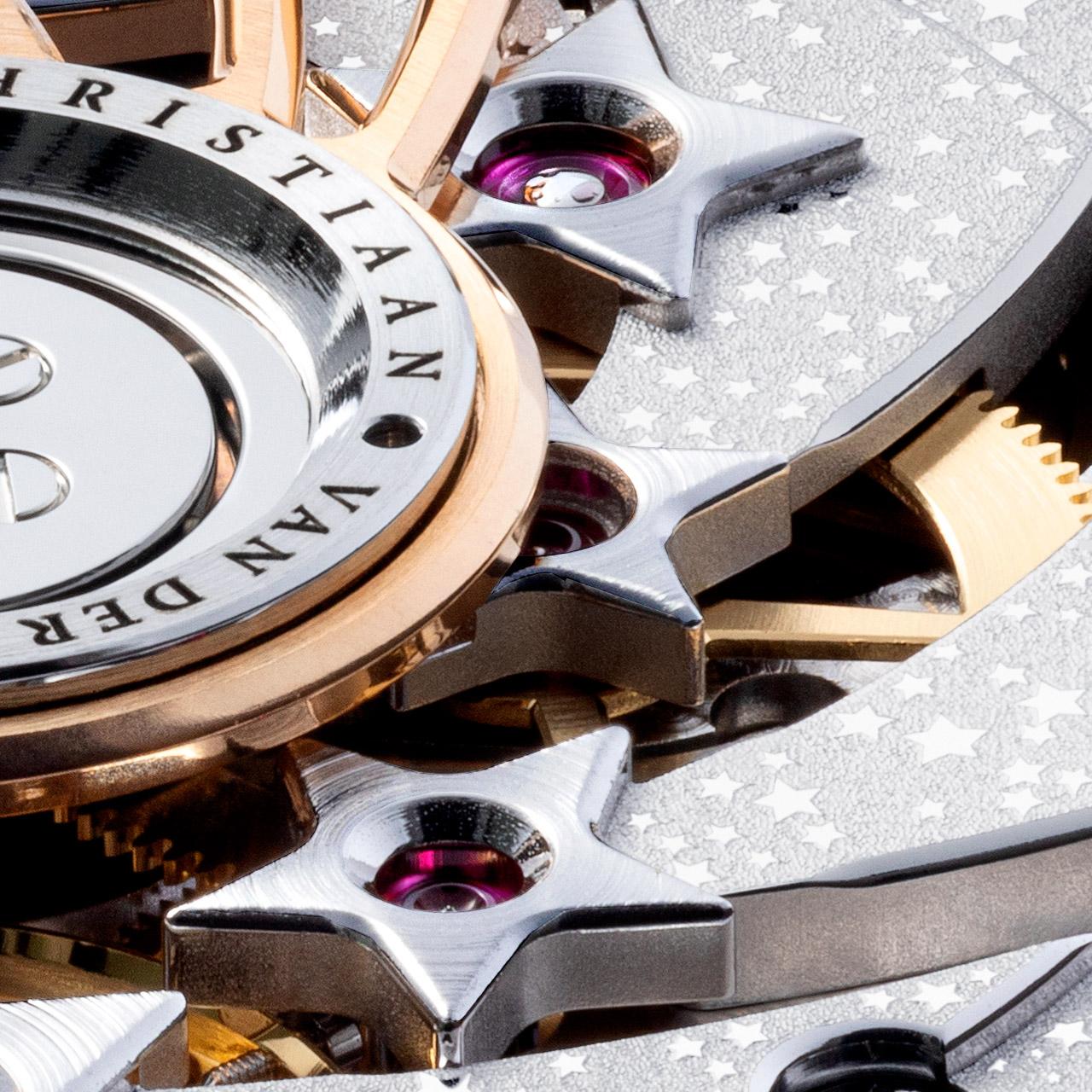
Price of the CVDK Grand Planetarium Eccentric Manufacture
All this handwork and delicate techniques cost a lot of time to make and assemble. The brand hopes to make about 10 to 15 of these watches a year and the price tag of this Grand Planetarium Eccentric lies around 175 to 250k, depending on your currency.
The watch comes on a black leather strap with a case matching folding clasp with the CVDK logo.
Ready for the third generation
As the second generation, Daniël and Maria Reintjes have managed to transform the legacy of Christiaan van der Klaauw into a multiple-price-winning player in the international watch world. With stunning and remarkable models. The creativity of this sympathetic couple will be missed.
For the third generation of the brand, CEO Pim Koeslag, this Christiaan van der Klaauw Grand Planetarium Eccentric Manufacture marks a new beginning. He will put his ideas, creativity, network, and technical know-how into the continuation of this small but remarkable great astronomical brand.

| Technical data and specifications of the Christiaan van der Klaauw Grand Planetarium Eccentric Manufacture |
| Reference number: CKGP1104 (rose gold) CKGP2204 (platinum) |
| Movement: Christiaan van der Klaauw caliber CKM-01 with Grand Planetarium Eccentric module | Automatic | Diameter: 30 mm (13¼ lignes) | Frequency: 21,600 vph (3 Hz) | Parts: 365 | Jewels: 30 | Quick planet setting | Hours, minutes, seconds (rotating sun in the center), date, month, zodiac indicator (all three not mechanical), (eccentric) planetarium | Power reserve: 60 hours |
| Case and dial: 44 mm | 18k rose gold or 950 platinum | Thickness: 14.3 mm | Domed sapphire crystal with anti-reflective treatment | Dial from aventurine (goldfluss) rings with pinned hand-painted 3D planets, and date/month/zodiac outer ring | Gold or platinum Breguet-style hour and minute hands | Hour markers engraved in sapphire crystal | Ribbed 18k rose gold or 950 platinum crown | Sapphire crystal case back | Water resistance: not provided |
| Strap: Dark blue leather strap | 18k rose gold or 950 platinum folding clasp with CVDK logo |
| Price Christiaan van der Klaauw Grand Planetarium Eccentric Manufacture: approx. $ 230,000 | € 208.000 | approx. £ 175,000 | approx. CHF 200’000 (rose gold) approx. $ 250,000 | € 227.000 | approx. £ 190,000 | approx. CHF 215’000 (platinum) |
| Website: www.klaauw.com |
